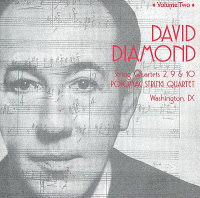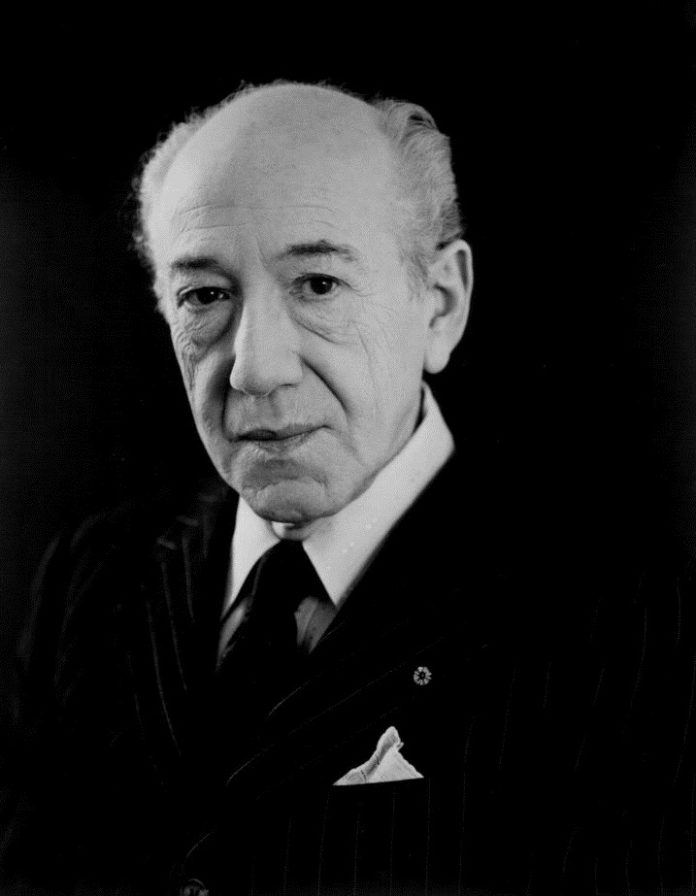The American composer David Diamond would seem to have been something of a master of unfortunate timing. Holding to the indispensability of melody and traditional compositional techniques when both were thought to be in eclipse, he nevertheless remained active and even prolific, writing no less than eleven symphonies and ten numbered string quartets, among many other works.
Diamond (1915-2005) began composing at an early age, having written as an eighteen year-old a one-movement symphony that was performed at the Eastman School of Music, which he had attended. After studies with Roger Sessions in the mid-1930s he made the first of several trips to Paris, during which he met Ravel—a great and continuing influence—and studied with Nadia Boulanger, although the student-teacher relationship appears to have been difficult for both. Following successes in the 1940s, he moved to Europe in 1951 largely for political reasons and stayed there until 1965. During this period not only his political views but also his compositional style was at odds with the prevailing norms. These were the years when serialism was in ascendency in America and when more radical work by John Cage, Earle Brown, the West Coast experimentalists and others was beginning to assert an influence on musical culture as well as on the culture at large. Diamond pushed against these trends by positing a commitment to lyrical inventiveness in opposition to what he considered a conceptually-driven asceticism. With the revival of interest in tonality that began in the late 1970s, interest in Diamond’s music likewise was resuscitated. In more recent years, recording projects have made much of his work available on CD.
In the early 2000s, the Potomac String Quartet, a Washington DC chamber ensemble consisting of Steven Honigberg (cello), George Marsh and Sally McLain (violins), and Tsuna Sakamoto (viola), undertook the recording of all of Diamond’s string quartets. The collection was issued as a series of four CDs. The second volume in the set, recorded in Washington in 2001, contains three subtly contrasting quartets spanning a twenty-year period.
Although written seventy years ago, Diamond’s three-movement String Quartet No. 2 of 1943-1944 has a fresh, open sound. As with his other quartets, the Second embodies the traditional contrapuntal value of construction by independent line. The lyricism of this particular work consists in the long phrases in which its melodies are couched, their intersections and divergences giving the impression of constantly changing time signatures even as the basic pulse is never less than clear and regular. As played by the Potomac, the quartet’s forward drive is unrelenting, like an update of the contrapuntal perpetuum mobile of the Baroque. The middle slow movement is notable for having the main melody carried by the viola, before giving way to the rapidly accelerating final movement. In this quartet as in the later Ninth and Tenth, Diamond makes good use pizzicato for color and textural effects, sometimes distributing a line between bowed and plucked passages or having the cello play an asymmetrical pizzicato figure against the other three voices.
 String Quartet No. 9 was written for the occasion of Roger Sessions’ 70thbirthday in 1966 and finished two years later. As Diamond recalled, he and Sessions became quite close over the years, and if the quartet was meant as a portrait it drops hints of a complex, multifaceted personality, at least to judge by the alternation of agitated and serene passages. Overall, though, this single-movement work is somewhat darker than the second quartet, reflecting as it does Diamond’s increased use of chromaticism later in his career. Consequently the harmonies that emerge from its counterpoint are more “modern” and dissonant, but not tonally disorienting.
String Quartet No. 9 was written for the occasion of Roger Sessions’ 70thbirthday in 1966 and finished two years later. As Diamond recalled, he and Sessions became quite close over the years, and if the quartet was meant as a portrait it drops hints of a complex, multifaceted personality, at least to judge by the alternation of agitated and serene passages. Overall, though, this single-movement work is somewhat darker than the second quartet, reflecting as it does Diamond’s increased use of chromaticism later in his career. Consequently the harmonies that emerge from its counterpoint are more “modern” and dissonant, but not tonally disorienting.String Quartet No. 10 (1966), the final string quartet Diamond wrote, is a highly expressive three-movement work that wraps its Romantic gestures in a language informed by dissonance. Although at times it seems to approach a free atonality it maintains an essentially traditional sense of form: The first movement is organized around variations on a rhythmic motif, while its closing movement features a double fugue.
In a sense, Diamond’s quartets hint at a kind of alternate history of 20thcentury music. In this counterfactual world serialism was bypassed in favor of the further development of the freer tonality of the early part of the century, leading to a music just modern enough to be harmonically piquant and yet still retaining traditional formal structures.







